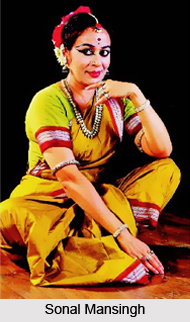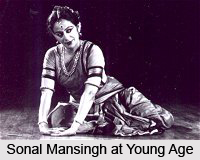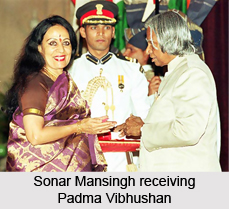 A dancer is not just a dancer. She is a part of this environment. She does not exist in a vacuum. Society and its happenings have an impact on all individuals, specially artistes. If an art form does not reflect the existing milieu, it stagnates." - asserts Sonal Mansingh. To her dance is a part of the environment and dance forms should reflect issues of the society and she firmly believes that art forms has the power to bring even countries closer. Some of her choreographic works reflects issues concerning women and environment.
A dancer is not just a dancer. She is a part of this environment. She does not exist in a vacuum. Society and its happenings have an impact on all individuals, specially artistes. If an art form does not reflect the existing milieu, it stagnates." - asserts Sonal Mansingh. To her dance is a part of the environment and dance forms should reflect issues of the society and she firmly believes that art forms has the power to bring even countries closer. Some of her choreographic works reflects issues concerning women and environment.
Sonal Mansingh is one of the finest classical dancers of the country, who has made her mark in the field of Odissi Dance. She was born on 1st May 1943 to a devout mother Poornima Pakvasa who had a love for creative art. Sonal Mansingh took up dance as profession at a time when it still had not gained respectability as a profession. Prejudices still exist in order that a dancer was called names like `nautch girl`, she did not pay heed to such snide remarks. She grew up in a family, which emphasized through their living, the values of the free Indian spirit. Her grand father Mangaldas Pakvasa, a freedom fighter was a man who believed in equality of gender. He instilled in her, timeless values that she still cherishes today and encouraged her artistic talents, which she wanted to use to serve the cause of culture with dignity through dance. So the support from grandfather and mother to learn dance raised the great dancer.

Sonal learnt Bharatanatyam from Prof. U S Krishna Rao and Chandrabhaga Devi at Bangalore besides lessons from other gurus and teachers belonging to the Pandanallur School. Sonal got inclined towards Odissi, when the dance style was getting strengthened and restructured. She learnt almost all the dance form. Sonal magnified her dance by acquiring the different strands of Odissa culture. During this augmentation, she also has had training in the performing arts of Chhau and Pala Sangeet. Sonal has been highly acclaimed for her mastery over the dance of Odissi. She has been on stage since 1964.
Her work has adopted both form and content. Lately her work has swerve more and more towards issues concerning women, environment, prison reforms and re-interpretation of ancient myths. Her renowned choreographic works based on Indian Mythology as well as contemporary issues are `Indradhanush`, Manavatta`, `Sabras`, `Devi Durga`, `Aatmayan`, `Mera Bharat`, `Draupati` etc. She has given performances all over India and abroad and Sonal has been highly acclaimed for her mastery over the dance of Odissi.
 The exceptional talent of Sonal has attested her with many awards and honors. She has won `Nritya Choodamani` in 1985, `Sangeet Natak Akademi Award` in 1986, `Bhai Veer Singh International Award` in 1990, `Rajiv Gandhi International Award` in 1991, `Singar Mani` from Haridas Sangeet Sammelan and `Medals of Friendship from State Council of Vietnam & Cuba`. She also became the youngest receiver to get the title of `Padma Bhushan` in 1992 on the top of it.
The exceptional talent of Sonal has attested her with many awards and honors. She has won `Nritya Choodamani` in 1985, `Sangeet Natak Akademi Award` in 1986, `Bhai Veer Singh International Award` in 1990, `Rajiv Gandhi International Award` in 1991, `Singar Mani` from Haridas Sangeet Sammelan and `Medals of Friendship from State Council of Vietnam & Cuba`. She also became the youngest receiver to get the title of `Padma Bhushan` in 1992 on the top of it.
To add to her honor, she was honored highest prestigious award by government `Padma Vibhushan` in 2003 and herewith she became the first woman dancer to collect this prestigious award in sovereign India. On her completing 40 years of dancing, a documentary film complimented Sonal by the title of "SONAL" made by Prakash Jha. Sonal also actively works for the upliftment of women and preserving nature.
More recently she has been appointed a Trustee of the largest institution in India, the Indira Gandhi National Center for the Arts (IGNCA). Apart from that Sonal is a Member of the Executive Board and General Council of Sangeet Natak Akademi, National Cultural Fund, Ministry of Culture.
This innovative performer has never failed to reinvent herself with supple and foxy movements have given depth and meaning to her themes.



















